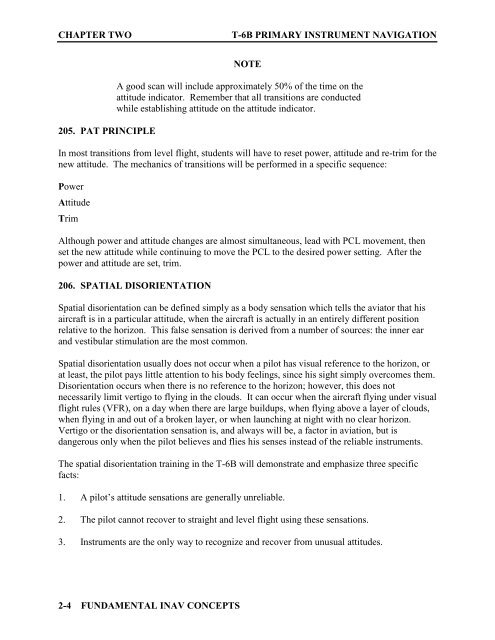Flight Training Instruction - Cnatra - U.S. Navy
Flight Training Instruction - Cnatra - U.S. Navy
Flight Training Instruction - Cnatra - U.S. Navy
Create successful ePaper yourself
Turn your PDF publications into a flip-book with our unique Google optimized e-Paper software.
CHAPTER TWO T-6B PRIMARY INSTRUMENT NAVIGATION<br />
205. PAT PRINCIPLE<br />
2-4 FUNDAMENTAL INAV CONCEPTS<br />
NOTE<br />
A good scan will include approximately 50% of the time on the<br />
attitude indicator. Remember that all transitions are conducted<br />
while establishing attitude on the attitude indicator.<br />
In most transitions from level flight, students will have to reset power, attitude and re-trim for the<br />
new attitude. The mechanics of transitions will be performed in a specific sequence:<br />
Power<br />
Attitude<br />
Trim<br />
Although power and attitude changes are almost simultaneous, lead with PCL movement, then<br />
set the new attitude while continuing to move the PCL to the desired power setting. After the<br />
power and attitude are set, trim.<br />
206. SPATIAL DISORIENTATION<br />
Spatial disorientation can be defined simply as a body sensation which tells the aviator that his<br />
aircraft is in a particular attitude, when the aircraft is actually in an entirely different position<br />
relative to the horizon. This false sensation is derived from a number of sources: the inner ear<br />
and vestibular stimulation are the most common.<br />
Spatial disorientation usually does not occur when a pilot has visual reference to the horizon, or<br />
at least, the pilot pays little attention to his body feelings, since his sight simply overcomes them.<br />
Disorientation occurs when there is no reference to the horizon; however, this does not<br />
necessarily limit vertigo to flying in the clouds. It can occur when the aircraft flying under visual<br />
flight rules (VFR), on a day when there are large buildups, when flying above a layer of clouds,<br />
when flying in and out of a broken layer, or when launching at night with no clear horizon.<br />
Vertigo or the disorientation sensation is, and always will be, a factor in aviation, but is<br />
dangerous only when the pilot believes and flies his senses instead of the reliable instruments.<br />
The spatial disorientation training in the T-6B will demonstrate and emphasize three specific<br />
facts:<br />
1. A pilot’s attitude sensations are generally unreliable.<br />
2. The pilot cannot recover to straight and level flight using these sensations.<br />
3. Instruments are the only way to recognize and recover from unusual attitudes.
















